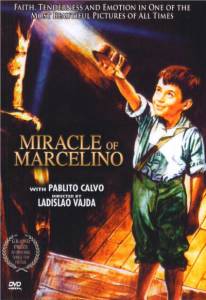Movies
Marcellino Pane e Vino
 The story revolves around Marcelino, an orphan abandoned as a baby on the steps of a monastery in nineteenth-century Spain. The monks raise the child, and Marcelino grows into a rowdy young boy. He has been warned by the monks not to visit the monastery attic, where a supposed bogeyman lives, but he ventures upstairs anyway, sees the bogeyman and tears off back down the stairs.
The story revolves around Marcelino, an orphan abandoned as a baby on the steps of a monastery in nineteenth-century Spain. The monks raise the child, and Marcelino grows into a rowdy young boy. He has been warned by the monks not to visit the monastery attic, where a supposed bogeyman lives, but he ventures upstairs anyway, sees the bogeyman and tears off back down the stairs.
At a festival, Marcelino causes havoc when he accidentally lets some animals loose, and the new local mayor, a blacksmith whom the monks would not let adopt Marcelino because of his coarse behavior, uses the incident as an excuse to try to shut down the monastery.
Given the silent treatment by the monks, Marcelino gathers up the courage to once again enter the attic, where he sees not a bogeyman, but a beautiful statue of Christ on the Cross. Remarking that the statue looks hungry, Marcelino steals some bread and wine and offers it to the statue, which comes to life, descends from the Cross, and eats and drinks what the boy has brought him. The statue becomes Marcelino’s best friend and confidant, and begins to give him religious instruction. For his part, Marcelino realizes that the statue is Christ.
The monks know something is strange when they notice bread and wine disappearing, and arrange to spy on Marcelino. One day, the statue notices that Marcelino is pensive and brooding instead of happy, and tells him that he would like to reward his kindness. Marcelino answers: “I want only to see my mother, and to see Yours after that”. The statue cradles Marcelino in its arms, tells Marcelino to sleep – and Marcelino dies happy.
The monks witness the miracle through a crack in the attic door, and burst in just in time to see the dead Marcelino bathed in a heavenly glow. The statue returns to its place on the Cross, and Marcelino is buried underneath the chapel and venerated by all who visit the now flourishing monastery-turned-shrine.
The main story is told in flashback by a monk (played by Fernando Rey), who, visiting a dying girl, tells her the story of Marcelino for inspiration. The film ends with the monk entering the now completely remodeled chapel in the monastery during Mass, and saying to the crucifix once kept in the attic: “We have been speaking about You, O Lord”, and then, to Marcelino’s grave, which is situated nearby, “And about you, too, Marcelino”.
The film remains one of the most famous and successful Spanish films ever made in history, and one of the first Spanish films to become successful in the U.S. as well.